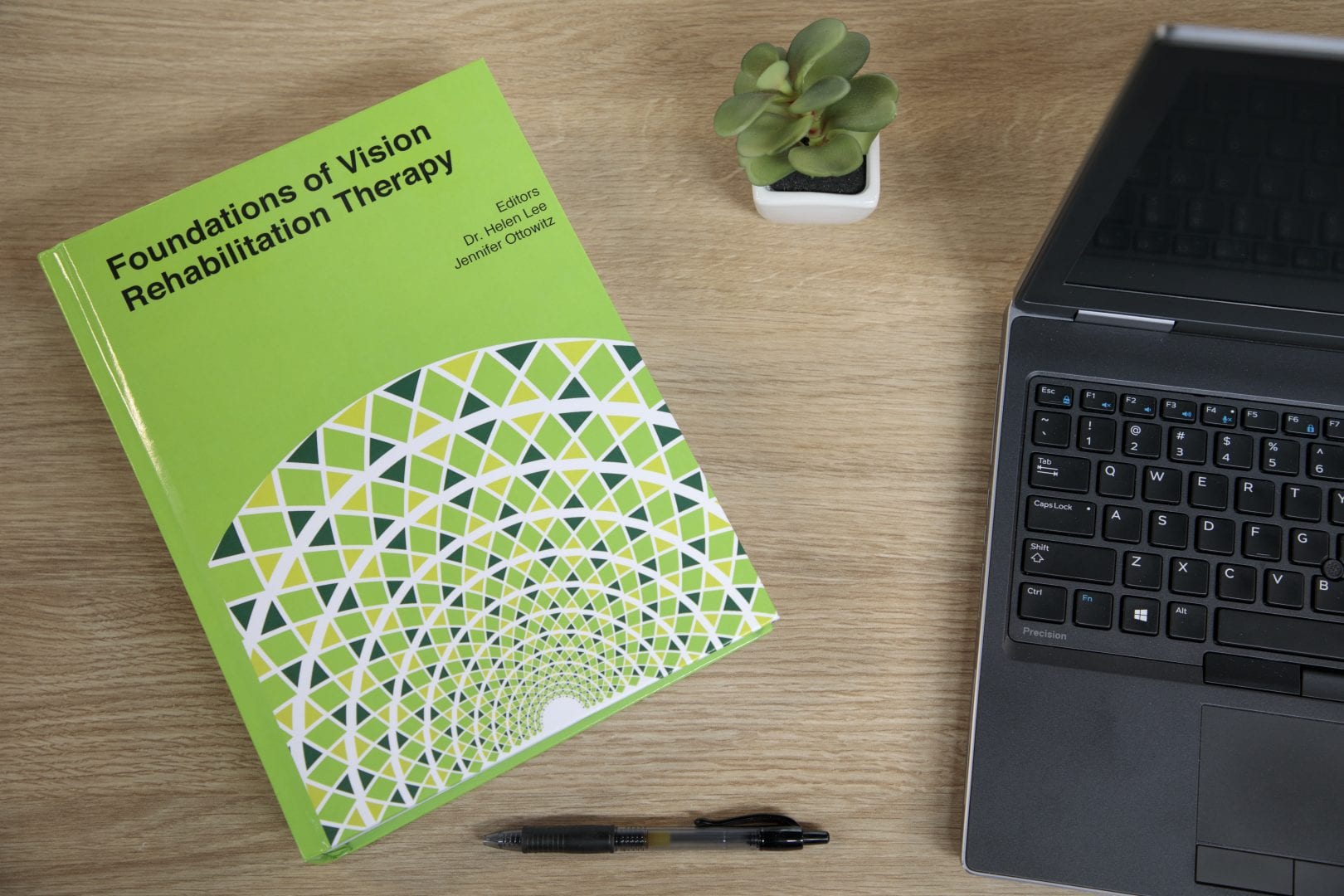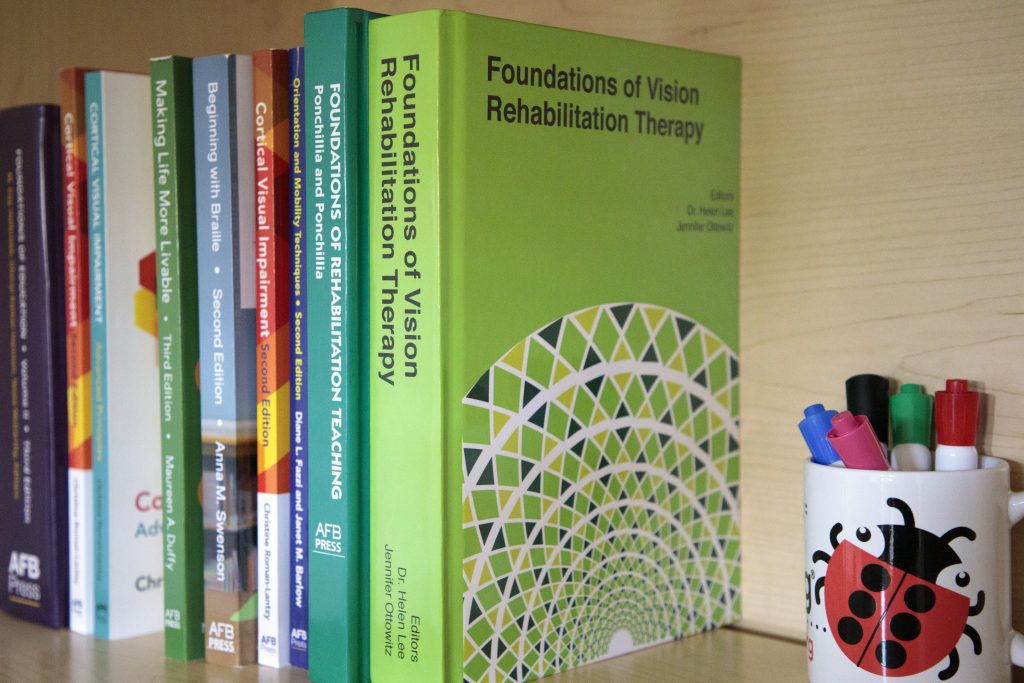To ensure gift delivery by 12/25, please place orders via UPS shipping no later than 12/17.
CloseFoundations of Vision Rehabilitation Therapy: Providing A New Perspective on the Field

Vision rehabilitation therapists change the lives of people who are blind, visually impaired, or have multiple disabilities every day. We’re excited to announce an update to an important VRT resource! Meet the new Foundations of Vision Rehabilitation Therapy textbook, an expansive introduction to the profession, and learn about the changes made to modernize this well-known text.
“We want to provide a foundation of skills for the profession and provide standards of practice,” said editor Jennifer Ottowitz.
A Change
Foundations of Vision Rehabilitation Therapy is the second edition of Foundations of Vision Rehabilitation Teaching with Persons Who Are Blind or Visually Impaired, which was written in 1996. A recent update to the field is the title change from “teachers” to “therapists.”
At their March 2004 board meeting, the Academy for Certification of Vision Rehabilitation and Education Professionals (ACVREP) revealed that due to copyright violations, the name Rehabilitation Teacher Certified (RTC) had to be changed. The Association for the Education and Rehabilitation of the Blind and Visually Impaired (AER) and AER’s Division 11 (Rehabilitation Teaching) supported this decision.
In September 2004, the ACVREP Board of Directors reviewed five name suggestions from ACVREP’s Rehabilitation Teaching (RT) Committee. They wanted a name that wasn’t copyrighted; was different from other certifications; defined the population they served; and that satisfied Medicare. At the November 2004 ACVREP board meeting, the board voted and chose the name “Certified Vision Rehabilitation Therapist” (CVRT). They went with “vision” because that encompasses all levels of vision, where if you hear the word “blind,” people with low vision wouldn’t identify with it.
“We serve the whole spectrum of vision,” said Jennifer. ” ‘Teacher’ comes from an educational model. We chose the term ‘therapist’ to align ourselves more with the medical model to get payment through third-party services like Medicare. Before, rehabilitation teachers were not recognized by Medicare, and other agencies would look for other professionals to perform services that we can provide. We are still striving to be approved by Medicare, but now this goal is easier to attain due to the title change.”
Jennifer and fellow editor, Helen Lee, also define what it means to be a vision rehabilitation therapist.
“The profession of vision rehabilitation therapy is unique in that it is a hybrid between a rehabilitation therapist and teacher,” said Jennifer and Helen. “As a rehabilitation therapist, the VRT provides adaptive strategies that restore function, while the teaching aspect requires training beyond those received in clinical settings. The VRT educates his or her clients in skills promoting self-sufficiency through strategies and problem-solving in the real-world setting.”
More About the Book
Along with its predecessor, the new Foundations of Vision Rehabilitation Therapy textbook is one of the few references to the field of vision rehabilitation therapy. For this reason, it is important that the book be updated to reflect the professionals’ title change and advances of the field. ACVREP can also reference and pull information from the textbook the next time they rewrite the VRT certification exam.
Foundations of Vision Rehabilitation Therapy provides updated information and techniques for professionals who assist transition-age students and adults who are blind and visually impaired, and who have multiple disabilities. Thirteen authors, opposed to two from the previous edition, add their expertise to the text.
“We have people who have worked in private agencies, state agencies, as itinerants, center-based, people who worked in supervision and direct service, and new and seasoned professionals,” said Jennifer.
The book’s fifteen chapters discuss the different areas of service that VRT’s provide including psychosocial aspects of vision loss, personal management, recreation, braille, access technology, handwriting, other tactile forms of communication, adaptive kitchen skills, labeling objects, threading a needle, indoor O & M, and more. The text also contains information about how to reinforce the use of low vision aids in daily living activities for low vision clients.
“The new textbook does include a section on VRTs who are visually impaired,” said Jennifer. “It talks about what these therapists can do to monitor their clients’ performance and safety.”
High Hopes
The editors, Jennifer and Helen, are excited to get this new resource into the hands of professionals.
Through reading the book, Jennifer hopes that professionals will receive “a foundation of skills, a breadth of knowledge, an appreciation for the history of our field, and insight into effectively working collaboratively with the people we serve.”
Helen adopts a similarly optimistic outlook. She hopes “that the readers recognize the contribution of a number of different authors has resulted in a product that embodies both a scholarly perspective as well as a practical “how-to” approach to serving our population. I also hope that the reader can feel the enthusiasm and passion that all of our authors feel about our profession and the people that we serve.”
Order today to get your copy of Foundations of Vision Rehabilitation Therapy in time for the spring 2021 semester.
Share this article.
Related articles

Foundations Bookshelf
Understanding the principles of the field of low vision and blindness is key to future success. APH Press’s Foundations series...
